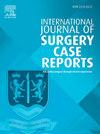Emergency multimodality imaging for a giant cystic renal artery aneurysm in a lung adenocarcinoma patient with iodinated contrast media allergy: A case report
IF 0.6
Q4 SURGERY
引用次数: 0
Abstract
Introduction and importance
Renal artery aneurysm (RAA) is a rare, but potentially life-threatening condition. The rarity of malignancy-associated RAAs limits our understanding of their natural history, morphological characteristics, intervention criteria, and available treatment options. When these aneurysms manifest as large cystic formations, they may mimic renal masses or cysts. Managing these aneurysms presents significant challenges, particularly for patients with contraindications to conventional imaging techniques, such as allergies to iodinated contrast agents.
Case presentation
This study presents a case of a 36-year-old male patient diagnosed with lung adenocarcinoma accompanied by pleural metastasis, who was suspected of having renal aneurysms. Due to an allergy to iodine contrast agents, the patient was unable to undergo computed tomography angiography (CTA). To address this challenge, we developed an emergency multimodal imaging pathway utilizing non-enhanced computed tomography (CT), Doppler ultrasound, and contrast-enhanced ultrasound (CEUS) for patients allergic to iodine contrast agents. This approach offers significant advantages, including reduced diagnostic time, the use of a safe blood pool microbubble contrast agent, and high spatial resolution. Ultimately, the patient was diagnosed with saccular RAA and underwent immediate surgical intervention, including renal artery reconstruction. The surgery was completed successfully and without complications. After treatment, the patient experienced rapid remission of symptoms related to the renal aneurysm.
Clinical discussion
This case illustrates the efficacy of a multimodal imaging approach—comprising CT, US, and CEUS—in the emergency diagnosis of RAA, particularly for patients with contraindications to iodinated contrast agents. While CTA is often considered the gold standard, it is associated with limitations such as radiation exposure and potential nephrotoxicity. In light of these constraints, the integration of non-contrast CT, conventional US, and CEUS proved to be an optimal strategy, yielding comprehensive diagnostic information without incurring the risks associated with iodinated or gadolinium-based contrast. CEUS, in particular, proves invaluable by providing real-time, high-resolution imaging of blood flow patterns within the RAA, a capability that conventional US alone cannot achieve, which is essential for differential diagnosis and treatment planning. This multimodal approach addresses the limitations of single-modality techniques by delivering anatomical, morphological, and functional data. It is especially advantageous for oncology patients who require frequent imaging and long-term follow-up, as it mitigates cumulative radiation exposure. The use of microbubble contrast agents in CEUS offers an extremely low risk of allergic reactions and is not affected by renal function, providing reliable diagnostic support. The rapid and accurate diagnosis facilitated by this multimodal strategy is critical in emergency settings, potentially averting severe complications such as aneurysm rupture. Nonetheless, this approach may face challenges related to operator dependency and the necessity for specialized equipment.
Conclusion
This case highlights the essential role of multimodal imaging in the emergency diagnosis of RAA, especially in oncology patients with a history of severe allergic reactions to iodinated contrast agents. It also underscores the need for rapid diagnosis and intervention for RAA in patients with malignancies, demonstrating how multimodal imaging enhances diagnostic accuracy while minimizing risks associated with contrast agents.
求助全文
约1分钟内获得全文
求助全文
来源期刊
CiteScore
1.10
自引率
0.00%
发文量
1116
审稿时长
46 days

 求助内容:
求助内容: 应助结果提醒方式:
应助结果提醒方式:


